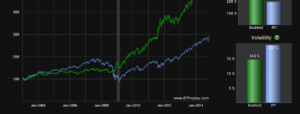
Last week, I was unable to produce a newsletter so I will be updating my analysis from two weeks ago. Fortunately, nothing has changed much as the ongoing levitation of asset prices in hopes of “tax cuts/reform” still linger even as the risk of disappointment seems to have risen.
On Thursday and Friday, the market experienced a very minor “sell off” as concerns over the “tax cut” bill surfaced. But even those concerns were rapidly offset by the “buy the dip” crowd with the S&P 500 finishing the week lower by sliding -5.56 points or -0.21%.
OMG – “There’s blood in the streets.”
I jest, of course, but there are a couple of indicators which point to a further decline in the next week. The chart below is the NYSE Advance-Decline Line. The vertical dashed lines are points where the A/D line issued a “sell signal” which also corresponded with a corrective action in the S&P 500. Such a signal is on the verge of being issued currently.

Secondly, the A/D Issues and A/D Volume (50-day moving age) are at extremely high levels which previously suggested bigger corrective actions previously.
I will give you my theoretical timing for that correction in a moment.
Junk bonds, oh, excuse me, I mean “high yield” bonds are also turning lower. There has been a high correlation between the S&P 500 and “high yield” bonds since the financial crisis. While the downturn itself isn’t a “major alert,” when combined with deteriorating internals, weakness in price momentum and extreme deviations from long-term means, we shouldn’t dismiss the warning.

Importantly, as I addressed two weeks ago, the “seasonally strong period” of the market was confirmed by both of the weekly MACD’s registering “buy signals” in October. Again, the only concern is that those signals were triggered from extremely high levels which tend to be shorter in nature.
Nonetheless, the bullish trends do remain intact and the last two months of the year are typically bullish for asset prices. Understanding this, these conditions keep portfolios allocated towards equity risk currently.
Timing Of A Correction
I am not talking about the beginning of the next “bear market,” but I am suggesting we are likely to see a correction of 3-5% to work off the current extremes.
As shown in the chart below, I believe the current market momentum can carry the market through the end of the year to hit our year-end target of 2600. As noted, there will be a couple of bumps along the way particularly in the second week of December when mutual funds make their annual distributions. But with fund managers chasing markets to “close their performance gap,” the traditional year-end “Santa Claus” rally is likely.

It is the turn of the calendar where I see the potential for a bigger correction. Come January, I think there is a high-likelihood of “tax selling” by fund-managers to lock in gains, particularly if “tax reform” legislation has passed, as taxes won’t be due for 21-months (assuming late filing.)
That selling, combined with concerns over the Fed’s rate hike in December and reduction of the balance sheet, could facilitate a deeper correction of 3-5%.
Don’t laugh.
Considering we have had the longest stretch in market history without a 3-5% correction, a correction of such magnitude will “feel” much worse than it actually is.
Tax Bill Overview & Thoughts
On Friday, I discussed the two current tax bills with Scarlett Fakhar of Real Investment News:
There is a rising, and significant, probability that “tax reform” will fail to pass in the Senate. This would delay the passage of tax reform bill until well into 2018, and possibly 2019 assuming the Republicans can hold majorities in both houses next November. Such is a slim possibility at best.
I encourage you to take a few minutes to review my previous analysis of the effectiveness of tax cuts on the economy.
This past week, Bloomberg produced a very concise comparison of both bills current presented. (Click HERE For The Full Analysis)













Leave A Comment